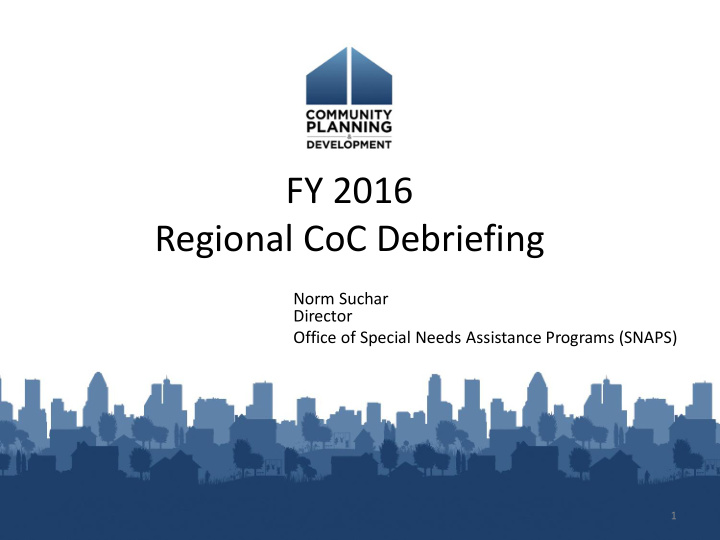



FY 2016 Regional CoC Debriefing Norm Suchar Director Office of Special Needs Assistance Programs (SNAPS) 1
Submitting Questions • Due to the high volume of participants, all participants will be muted throughout the presentation. • Questions can be posted at any time during the webinar via the “Questions” pane of Go -to-Meeting. • All questions that we do not have time to respond to should be submitted via the Ask A Question section on the HUD Exchange – selecting e-snaps in Step 2 2
Funding Overview Total Awarded: $1.95 billion • $124 million awarded to new PH projects through reallocation and PH Bonus – $70 million increase in PSH – $53 million increase in RRH • CoCs reallocated 5.8% of their funding 3
Policy Priorities 1. Create a Systemic Response to Homelessness 2. Strategically Allocate Resources 3. Ending Chronic Homelessness 4. Ending Family Homelessness 5. Ending Youth Homelessness 6. Ending Veteran Homelessness 7. Using a Housing first Approach 4
Tier 1 and Tier 2 • Tier 1 Projects – 93% of CoC’s ARD – Safe • Projects straddling Tier 1 and Tier 2 • Tier 2 Projects – Tier 2 projects compete for funding – Impacted by CoC score and other factors 5
Overview of Selection and Ranking HUD awarded a point value to each new and renewal project application in Tier 2 using a 100 point scale: • CoC Score – Up to 50 pts • CoC Project Ranking - Up to 35 points • Project Type - Up to 5 points • Commitment to Policy Priorities and Housing First - Up to 10 points 6
How did CoCs do well? CoCs that scored well and received increased funding did the following: • Reallocated lower performing projects, especially TH and SSO projects • Used performance criteria to rate and rank projects • Used Housing First practices • Reduced homelessness in their communities • Increased PSH and RRH units If you haven’t received your debriefing document please contact your field office. 7
Why weren’t projects funded? CoC overall Performance • CoCs that scored poorly were less likely to get projects funded • Increase in homelessness in the CoC’s geographic area • Fewer PSH units for chronic homelessness • Fewer RRH units 8
CoC Score by size (smallest CoCs on the left) 200 180 160 140 120 100 80 60 High: 187.75 Low: 79 40 Weighted Mean: 160.7 20 0 $1.85 Million $737 Thousand $4.54 Million Annual Renewal Demand 9
Why weren’t projects funded? (cont.) Project Performance • Projects needed 67.2 points to be selected • TH and SSO projects were less competitive • Projects lost points for not using Housing First practices • Projects that were at the bottom of their CoC’s Tier 2 were unlikely to be funded. • Strategies to prevent and end homelessness were inadequate 10
Reallocation • CoCs eliminated lower performing projects • On Average, CoCs reallocated 5.8% of their resources • Through reallocation, communities funded $92 million in new projects, including: – $42 million for Permanent Supportive Housing – $36 million for Rapid Rehousing – $12 million for new Coordinated Assessment – $3 million for new HMIS 11
Transitional Housing (TH) HUD awarded $107 million in TH funding in FY 2016 • $66 million less than in FY 2015 • 90 percent of the reduction was because of reallocation at the CoC level 12
Increasing Efficiency • 10% more Permanent Supportive Housing units over the past 2 years (113,180 to 124,371). • 22.5% more households served with residential programs over the past 2 years (177,427 to 203,784). • CoC grants for residential programs are serving 14.8% more households per dollar spent than with the FY 2014 grants. 13
CoC Funding History by Project Type CoC Funding History $1,800 $1,431 $1,407 $1,240 $1,200 $1,132 $1,034 $1,004 $997 $926 $782 $600 $435 $430 $433 $429 $417 $371 $326 $199 $249 $107 $99 $36 $173 $6 $0 2008 2009 2010 2011 2012 2013 2014 2015 2016 Permanent Suportive Housing Rapid Rehousing Transitional Housing 14
Guidance for Grants not Funded • Extending Grants with funds remaining • Grant Closeouts • Exiting program participants from projects • Restrictive Covenants (HUD Exchange) • Work with the Field Office • Request Technical Assistance 15
Questions? 16
Moving Forward Reducing Homelessness Monitoring Performance The Importance of Reallocation Reducing Barriers Targeting Resources to people of highest need 17
Recommend
More recommend